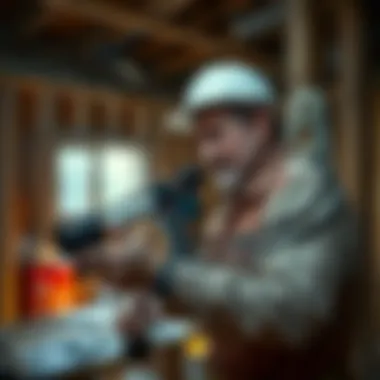The Essential Guide to Home Inspectors' Roles


Intro
The real estate journey is often a complex maze filled with questions, uncertainties, and pivotal decisions. Among the various players in this game, home inspectors emerge as crucial allies, ensuring that buyers and owners alike can navigate the intricacies of property assessment with confidence. Their role extends beyond merely checking off boxes on a checklist; they delve into the very foundation of a home, unearthing potential concerns that could lead to significant consequences down the road.
Understanding the scope of what home inspectors do is essential for any prospective homebuyer or property owner. The nuances of their duties, the qualifications they must possess, and the impact of their findings can dramatically shape real estate transactions. Armed with knowledge, one can enter the housing market with a sharper perspective, elevating the home-buying experience from a gamble to a well-informed decision.
In this guide, we will explore the vital role that home inspectors play in real estate, going over the essential aspects of their profession. From what constitutes a home inspection to the interplay between inspections and property decisions, we will cover it all.
Let's break it down.
Definition of Home Inspector
Understanding what a home inspector is can be crucial, especially when navigating the often daunting waters of real estate. A home inspector serves as an impartial third party whose main job is to assess the condition of a home before it changes hands. This description hardly scratches the surface, though. The depth of this role touches on various aspects that are vital for both buyers and sellers alike.
An Overview of the Role
The concept of a home inspector usually paints a picture of someone walking through a house with a clipboard in hand, checking off items as they go. But it’s much more complicated than that. Not only do these professionals evaluate the visible condition of a property, but they also gather extensive technical knowledge about systems like plumbing, electrical setups, and structural integrity.
During the inspection, they climb into attics, inspect basements, and even traverse rooftops in pursuit of critical details that can span the gambit from minor issues to serious problems. It’s not just a job; it’s a responsibility that holds significant weight in any transaction. The findings from these inspections can change minds and decide the fates of deals, making them a cornerstone of the real estate process.
Importance in Real Estate Transactions
When it comes to real estate, the stakes can be sky high. A home is often the most significant purchase individuals will ever make. Thus, the importance of home inspections can’t be overstated. Here’s why:
- Uncover Hidden Flaws: A shiny new facade often masks significant underlying problems. Home inspectors root out these hidden flaws, which can save buyers from costly repairs down the line.
- Informed Decision-Making: With a good inspection report, buyers can make decisions based on facts rather than gut feelings. This leads to more informed negotiations and can even empower buyers to walk away if the issues are too severe.
- Peace of Mind: For sellers, having a pre-listing inspection can lead to smoother sales by addressing issues before buyers even get involved. This proactive approach often quickens the process and can even bolster the selling price by building trust.
"A house isn't just bricks and mortar; it's a collection of systems and functions that require careful inspection to ensure longevity and safety."
In summary, the role of a home inspector transcends mere observation. It embodies the essence of trust and transparency that underpins a healthy real estate market. Without their expertise, many buyers and sellers would be left in the dark, navigating a complex landscape without adequate information.
Key Responsibilities of Home Inspectors
Home inspectors play a pivotal role in the home buying and selling processes. Their key responsibilities serve as the backbone of a thorough property evaluation, ensuring that buyers and sellers alike have the information they need to make informed decisions. These responsibilities help to identify potential issues before they escalate, ultimately safeguarding investments and promoting transparency in real estate transactions.
Understanding what home inspectors do can clarify their impact on the real estate market and emphasize the necessity of their expertise.
Conducting Thorough Inspections
Home inspectors are tasked with a variety of inspections tailored to ensure that a home is safe and operational. This thorough approach encompasses several specialized assessments, each focusing on unique aspects of the property.
Structural Inspections
Structural inspections are crucial for identifying potential weaknesses in a home's foundational elements. Inspectors assess the integrity of the house structure, including walls, ceilings, floors, and the foundation itself. This aspect is key in determining a house's longevity and safety, making it a beneficial choice. A notable characteristic of structural inspections is their capability to highlight hidden issues, like cracks in walls or shifting foundations. The uniqueness here is that these flaws may not be visible at first glance and could lead to costly repairs if left unchecked.
However, structural inspections do have their challenges. For instance, different materials and techniques used in construction may require inspectors to adapt their evaluation methods, potentially impacting their effectiveness. Yet, the insight these inspections provide often outweighs the limitations they may face.
Electrical and Plumbing Assessments
Moving onto electrical and plumbing assessments, these evaluations are equally essential. They help ensure that the home's systems are safe and functional. Here, inspectors identify outdated wiring, potential fire hazards, or plumbing system leaks that could result in extensive water damage later. A strong point of these assessments is their emphasis on safety, which, in turn, gives buyers peace of mind regarding the property's infrastructure.
A particular feature of electrical assessments is the ability to pinpoint code violations. Identifying these violations not only enhances safety but also legally protects the buyer in the long run. On the downside, plumbing and electrical issues can often be intricate, requiring a deeper dive than might be feasible in a standard home inspection.
Roof and Exterior Evaluations
Next, roof and exterior evaluations are fundamentally vital for the overall condition of a home. These inspections look at roof materials, drainage systems, and exterior walls to spot potential weather-related damages. This aspect of inspections can often catch things like water damage or old shingles before they become bigger problems. The uniqueness in roof evaluations lies in their potential to predict future maintenance needs – essentially, an early warning system for homeowners.
One advantage of these evaluations is that they can often lead to proactive repairs, which maintain property value over time. However, exterior inspections can be hampered by weather conditions, leading to incomplete assessments during bad weather days.
Reporting Findings
After conducting a thorough inspection, the next big task falls to reporting the findings to the clients. This documentation process holds significant importance, as it allows homebuyers to understand their investment comprehensively.
Creating Detailed Inspection Reports
The creation of detailed inspection reports is a cornerstone of the inspector's responsibilities. These reports summarize the inspection findings and highlight the overall condition of the home. They offer a standardized format that allows clients to see at a glance potential areas of concern. A distinguishing feature of these reports is how they translate technical jargon into layman's terms, enabling buyers to comprehend complex issues.
Creating these reports can also lead to an effective communication tool between buyers and sellers, as each party can refer back to key points noted in the documentation. Although thorough reports are time-consuming to create, their clarity and depth significantly enhance the buyer's understanding of what they are getting into.
Highlighting Major Concerns
Highlighting major concerns within the reports is another critical function of home inspectors. Any serious issues that could affect the safety or value of the property are flagged immediately. This process not only helps buyers prioritize repairs but also arms them with important information when negotiating purchase terms. Crucial characteristics of this aspect include the immediacy with which these findings can affect negotiations.
However, distinguishing between minor and major issues can sometimes be subjective, leading to potential misunderstandings between inspectors and homebuyers. Nevertheless, clear communications about these major concerns can significantly contribute to a successful transaction.
Offering Maintenance Recommendations


Finally, home inspectors offering maintenance recommendations encapsulates their role in the property’s ongoing upkeep. These suggestions provide valuable insights on regular maintenance tasks and how homeowners can prevent future problems. The benefit of this is that it promotes long-term property health and helps homeowners retain value.
Unique to this responsibility is that it serves not only the current owner but also prospective buyers who can plan for future maintenance needs. However, one down side is that not all recommendations may be realistic given a homeowner's budget or time constraints, making it vital for inspectors to balance practicality with thoroughness.
Qualifications for Becoming a Home Inspector
Becoming a home inspector is no walk in the park. It takes a certain level of education, training, and experience to ensure that an inspector can accurately assess a property's condition. This segment of the article aims to delineate what qualifications are necessary, how they contribute to the role of a home inspector, and why they matter in the grand scheme of real estate transactions.
Educational Requirements
Relevant Degrees
When we talk about relevant degrees for home inspectors, we often focus on fields like construction technology, engineering, or architecture. Possessing a degree in one of these areas equips an inspector with a solid foundation in understanding how structures are built. This knowledge is key, as it allows inspectors to identify potential structural issues that could compromise safety or integrity.
One key characteristic of obtaining a degree is that it opens up more professional doors. Unlike someone who just jumps into an inspection role without formal education, those with degrees typically command more respect from clients. They also often find it easier to build a clientele.
That said, some degree programs can be costly and time-consuming—you could be looking at several years of schooling. However, if you're serious about a long-term career, it’s often worth the investment. After all, a well-informed inspector is a more effective one.
Certifications and Licensure
Certifications and licensure are non-negotiable in many states. They can help set a home inspector apart from the crowd. While a degree might give a strong foundation, certifications demonstrate a commitment to the profession. It shows that the inspector has undergone specialized training and has passed exams specific to home inspection.
Another important aspect is the credibility that comes with being licensed. Clients tend to feel more secure hiring someone who possesses a valid license and industry-recognized certifications. Moreover, certifications often require ongoing education, which keeps inspectors up-to-date with new codes or technologies—an advantage in a fast-evolving field like real estate.
Yet, keep in mind that some certifications have associated costs that might put them out of reach for some aspiring inspectors. It's a double-edged sword—while they can bolster your qualifications, they can also be a financial hurdle for entry into the profession.
Training and Experience
Apprenticeship Programs
Apprenticeship programs are crucial when it comes to training effective home inspectors. These programs typically pair newcomers with experienced inspectors, who pass on invaluable wisdom gleaned from years in the field. This hands-on training is invaluable—it allows budding inspectors to apply their theoretical knowledge to real-world situations.
One key feature of these programs is that they offer a structured way to gain experience. You've got that mentor to guide you, helping you avoid common pitfalls in the early stages of your career. Plus, you’ll end up with a portfolio that showcases real inspections, which can be beneficial when looking for your first job or clients.
However, these programs may require a time commitment without immediate financial reward. Many apprenticeships are unpaid or offer minimal compensation, which can deter some from pursuing this avenue.
Ongoing Education
Ongoing education is a must in this line of work. The home inspection field is continuously changing, whether it's new technology, updates in building codes, or evolving consumer expectations. Keeping up with these shifts requires a commitment to lifelong learning.
One of the standout aspects of ongoing education is that it keeps an inspector relevant and competitive in the market. Inspectors keen on enhancing their skills often take specialized courses, which can lead to new employment opportunities or additional services they can offer clients.
Nevertheless, it can feel like an uphill battle. Finding the time and financial resources for continual learning can be a roadblock, especially for inspectors just starting out. Balancing the demands of education with work commitments is no small feat, but it is essential for sustained success in the profession.
"Becoming a home inspector isn't just about checking boxes on a checklist; it's about acquiring a comprehensive understanding of the properties you're assessing."
As we have seen, the qualifications for being a home inspector are a vital component of the profession. They establish credibility, ensure competence, and ultimately lead to better client outcomes.
The Home Inspection Process
The home inspection process is a critical phase in the journey of purchasing or maintaining property. For both buyers and sellers, it provides crucial insights that can make or break a deal. Having a sound understanding of this process not only safeguards investments but also helps in setting the right expectations when entering the market.
Preparation for the Inspection
Scheduling and Costs
Scheduling a home inspection requires careful consideration and decent planning. Generally, it's best to arrange the inspection as soon as a purchase agreement is in place, as this helps to prevent any delays. The cost of a home inspection can range widely depending on the size and location of the property. Usually, a small apartment may set you back around $300, while larger homes can go upwards of $600 or even more.
The benefit of understanding scheduling and costs lies in its financial implications. Knowing upfront what you’re likely to pay helps in budgeting effectively. Many buyers mistakenly wait until the last minute to schedule inspections, which might lead to rushed decisions later on. Additionally, buyers should be aware that higher costs do not inherently equate to better service, but often, extensively certified inspectors can yield substantial peace of mind.
Pros and Cons of Scheduling and Costs
- Pros: Helps in budgeting; ensures timely inspections; aids in negotiating repair costs early.
- Cons: Cost can be high; last-minute scheduling may lead to sub-par inspections.
Preparing the Property
Preparing the property for an inspection is often overlooked but is quite essential. Homeowners should ensure that all areas of the property are accessible, including attics, basements, and around appliances. This not only enhances the effectiveness of the inspection but also demonstrates to potential buyers that the property has been well maintained. Setting the stage for a favorable inspection can mean simple things like clearing debris from roofs or providing easy access to crawl spaces. It might sound trivial, but ensuring that everything is shipshape can potentially save sellers on repair costs if issues do arise.
An organized, tidy property can influence an inspector's view of the overall condition of a home positively. A good first impression can come in handy for property values and negotiations.
Pros and Cons of Preparing the Property
- Pros: Enhances inspection efficiency; creates positive impressions; can lead to better negotiation outcomes.
- Cons: Time-consuming; may uncover unexpected issues.


Conducting the Inspection
On-Site Procedures
During the on-site inspection, the inspector meticulously evaluates various aspects of the property. They start from the roof down, examining elements such as the structure, roofing, and foundation. The procedure typically includes checking safety features, the functionality of systems, and assessing overall maintenance needs.
Each inspector may have different standard practices. However, what is critical here is that thoroughness and attention to detail are paramount. A comprehensive inspection could reveal hidden problems that the average buyer wouldn’t recognize.
Tools and Equipment Used
The tools and equipment employed during a home inspection are essential for a thorough evaluation. Most inspectors will carry out inspections with high-tech equipment including moisture meters, electrical testers, and even camera drones for roof assessments. For something like identifying heat leaks or water intrusion, these tools can provide insights that an untrained eye might miss.
The unique feature of this technological approach not only enhances accuracy but also saves time, allowing inspectors to cover larger areas effectively. Keeping up-to-date with modern equipment means inspectors can provide customers with the assurance that they are getting an accurate portrayal of the property’s state.
"A skilled inspector with the right tools can mean the difference between a good investment and a costly regret."
Epilogue
In summary, understanding the home inspection process—starting from preparation and costs to the actual inspection techniques and tools—empowers buyers and sellers alike to navigate the often murky waters of real estate transactions more effectively. It spotlights the value of informed decision-making, which is vital for both securing deals and maintaining properties.
After the Inspection: Next Steps for Buyers and Sellers
Once the home inspection wraps up, both buyers and sellers often find themselves at a crossroads. The inspection results can be a double-edged sword, giving invaluable insights but also stirring a myriad of emotions. Understanding what to do next becomes paramount; it’s where negotiations kick into gear and decisions must be made. This step can be the difference between making a smooth sale or hitting a snag in the process.
Interpreting the Inspection Report
Understanding Terminology
The inspection report can feel like it’s written in another language at times. It's crucial for both parties to fully grasp the nuances of the terminology used in the report. For example, words like "deferred maintenance" or "structural integrity" might sound intimidating, but they hold significant weight in negotiations. By getting a handle on the lingo, buyers can understand the gravity of certain issues, while sellers can effectively communicate their positions on repairs or costs.
Additionally, when buyers understand the terminology, they’re better equipped to know what counts as a deal-breaker versus a minor fix. Knowing that a “substantial” issue might lead to hefty repair costs helps prioritize discussions, paving the way for clear, informed negotiations.
Evaluating Urgency of Repairs
After deciphering the terms, the next step is evaluating how urgent specific repairs may be. Not everything flagged in an inspection report requires immediate attention. For instance, a leaky faucet may be seen as a nuisance, whereas a compromised foundation would certainly be in the "must fix now" category. Identifying which repairs are crucial can help in making a stronger case during negotiations.
The ability to classify repairs into urgent, somewhat urgent, or non-urgent creates a clear action plan. This way, buyers can focus discussions around critical issues, while sellers can choose how best to respond — be it via price adjustments or agreeing to fix certain problems before closing.
Negotiating Repair Costs
Working with Sellers
Once the inspection report has been thoroughly understood, buyers will need to communicate with sellers about the findings. This often opens the door for negotiation. Engaging in discussions about repair costs can lead to various outcomes. Buyers may request that sellers cover repairs before the sale is completed or negotiate a reduction in the selling price.
A strong case will come from a well-constructed argument based on the report. Transparency in negotiations benefits both parties; it leads to a healthier relationship and smoothens the process. Knowing how to present findings effectively can create a favorable outcome for buyers, ensuring they aren’t left in the lurch with post-purchase headaches.
Adjusting Offer Prices
Ultimately, buyers may find the need to adjust their offer prices based on the report's findings. If significant concerns arise during the inspection, it can warrant a reevaluation of the initial offer. Buyers must be strategic here; approaching the seller with a revised offer grounded in evidence protects their interests. This might lead to a win-win situation where the seller feels respected, and the buyer receives a fair deal.
The act of adjusting offer prices isn’t just a financial adjustment; it conveys the seriousness of the issues uncovered during inspection. This potentially leads to a more transparent and positive relationship throughout the sales process, as it sets the tone for expected integrity in property transactions.
"Knowledge is power. Understanding your home inspection report equips you with the ability to navigate negotiations skillfully."
Common Misconceptions about Home Inspections
In the world of real estate, home inspections take center stage, offering vital insights into properties. Yet, surrounding this field are a myriad of misconceptions that can lead both buyers and sellers astray. Gaining clarity on these misunderstandings is essential, as it empowers individuals to make informed decisions during one of the most significant transactions of their lives. This section peels back the layers of common myths, exposing the truths that can dramatically affect how home inspections are perceived and utilized.
What Home Inspectors Do Not Cover
It’s easy to assume that home inspectors cover everything under the sun when they evaluate a property. However, that’s far from the truth. Understanding what is not included in a home inspection can save buyers from misconceptions and oversights.
- Cosmetic Deficiencies: Inspectors don’t often focus on surface-level issues. Things like scratched paint, outdated décor, or minor wear and tear fall outside their purview.
- Non-Visible Structural Defects: Inspectors might inspect visible signs, yet they can't predict hidden structural issues like foundation problems unless they're evident at the surface.
- Environmental Hazards: Whether it’s mold, radon, or other hazardous materials, many inspectors don’t conduct extensive environmental assessments or testing unless specialized.
It's critical for buyers to have realistic expectations. If buyers think home inspectors can reveal all hidden issues, they might face rude awakenings post-purchase. Better understanding sets the bar for what an inspection can realistically provide.
Limitations of Home Inspections
While home inspections are invaluable, they’re not a catch-all remedy. Recognizing their limitations helps to navigate the complexities of buying or selling property more effectively.
- Time Constraints: A standard home inspection rarely exceeds two to three hours. This limited timeframe inevitably restricts the depth of investigation.
- Visual Assessment: Inspectors mainly rely on visual cues. They don’t dismantle walls, move insulation, or conduct invasive procedures. If a fault isn’t visible, they might miss it.
- No Guarantees: Inspectors can identify major issues but cannot guarantee the continued performance of systems or materials. It's a snapshot of the home as observed on a particular day.
Understanding these limitations protects buyers and sellers from over-reliance on inspection reports. They should be seen as a foundational tool, not the sole deciding factor in property transactions.


“A home inspection provides a crucial lens into a property's condition, but it’s just one piece of a richer, complex puzzle.”
The Role of Technology in Home Inspections
In recent years, the home inspection industry has undergone significant changes due to advancements in technology. The integration of modern tools has transformed how inspectors assess properties, making the process more efficient and thorough than ever. With the wealth of information available, home inspectors can now deliver more accurate reports and insights to buyers and sellers alike. This segment of the article will delve into some cutting-edge technologies that are reshaping the home inspection landscape, specifically highlighting emerging tools and techniques, as well as examining their impact on the accuracy and efficiency of inspections.
Emerging Tools and Techniques
Thermal Imaging
Thermal imaging represents a revolutionary approach to home inspections. This technology enables inspectors to identify hidden issues behind walls, ceilings, and floors, which might otherwise remain unnoticed using traditional methods. The primary characteristic that makes thermal imaging stand out is its ability to detect heat differences, which can signify issues such as moisture intrusion, electrical faults, or insulation problems. Utilizing this technology can lead to a more comprehensive overview of a property's condition.
A unique feature of thermal imaging is its non-invasive nature; it allows for inspections without tearing apart walls or disturbing the property significantly. However, while thermal imaging is a powerful tool, it’s not without limitations. Notably, it requires skilled interpretation to ensure accurate conclusions. This aspect might be viewed as both an advantage and a disadvantage; it can expose issues, but if misinterpreted, it may lead to unnecessary alarm or overestimations.
Drones for Roof Inspections
Another groundbreaking innovation is the use of drones for roof inspections. Traditionally, assessing a roof's condition could involve ladders, scaffolding, and potentially hazardous climbing. Drones eliminate these risks, allowing inspectors to capture high-resolution images and videos from vantage points that would otherwise be challenging to access. The key characteristic that makes drones appealing is their ability to cover vast areas swiftly, leading to thorough evaluations of roof integrity.
Drones can also be outfitted with specialized cameras to detect wear and tear, observe gutter conditions, and identify potential leak sources. This unique feature provides inspectors with a clear visual representation of the roof's condition. While the efficiency and safety of drone usage are clear benefits, there are drawbacks to consider as well. For example, adverse weather conditions can hinder drone operation, and there may be legal restrictions regarding their use in certain areas.
Impact on Accuracy and Efficiency
The introduction of these technologies has had a profound impact on both the accuracy and efficiency of home inspections. By equipping inspectors with sophisticated tools like thermal cameras and drones, the likelihood of catching potential issues has drastically increased. Accurate reporting leads to informed decision-making for buyers, helping them avoid surprises post-purchase.
Moreover, these tools enhance efficiency. Inspectors can conduct thorough evaluations in a fraction of the time it would take with traditional methods, which not only benefits the inspector but also ensures that sellers and buyers spend less time waiting for results. The end result is that technology not only changes the way inspections are done but also promotes a level of transparency in the home-buying process that is crucial for making sound financial decisions.
In summary, the role of technology in home inspections cannot be overstated. As tools continue to evolve, they will further refine the inspection process and enhance the overall experience for all parties involved in real estate transactions. For those in the market, understanding these technological advancements can be the key to making well-informed decisions.
Importance of Home Inspections for Property Maintenance
Home inspections carry significant weight in maintaining property value and ensuring longevity for homes. They serve as a proactive approach that can save homeowners both time and money down the line. Recognizing that a small issue can snowball into a larger headache is crucial. Initiating regular home inspections can be the most strategic move for homeowners wanting to protect their investments.
The benefits of home inspections extend beyond the immediate sale or purchase of a property. Imagine owning a home where maintenance issues are identified early on. You can address problems like leaks in the roof or electrical issues before they disrupt your living space or create substantial expenses. It’s a wise strategy—one that homeowners should prioritize.
Regular Inspecting as Preventive Measures
Looking at home inspections through a preventive lens offers a different perspective. Regular inspections help identify deterioration before it becomes critical. Whether it's a small crack in the foundation or outdated wiring, catching these problems early saves you from a catastrophic failure later.
- Routine maintenance checkups: Just like taking your car in for regular oil changes, homes need similar attention. Set a schedule for an inspection every few years, depending on your home’s age and condition.
- Weather impacts: Harsh weather can take an unexpected toll on properties. A proactive inspection can shine a light on potential vulnerabilities.
- Appliances and systems: The HVAC system, plumbing, and electrical systems are the heartbeat of your home. Regular assessments ensure they’re functioning optimally and highlight small maintenance tasks that can prevent larger repair expenses.
"An ounce of prevention is worth a pound of cure." This old saying rings especially true in the realm of property maintenance.
Maintaining Property Value
Keeping a keen eye on property condition through inspections safeguards its value. The real estate market is ever-changing, and well-maintained homes are more attractive to buyers and appraisers alike.
- Market readiness: A house that shows signs of neglect can struggle during a sale. Buyers tend to shy away from properties that require too much work, often leading to lower offers.
- Investment protection: Regular inspections ensure that the property remains in optimal condition. This can result in retaining, or even increasing, its market value.
- Insurance benefits: Homeowners who systematically maintain their property and keep thorough inspection records may find themselves in a better position with insurers. Some companies even provide premium reductions for well-maintained homes.
In summary, understanding the importance of home inspections in property maintenance is vital. This oversight not only helps in identifying problems early but also ensures that a home retains its value within an ever-competitive market. Investing in regular assessments is investing in your future.
The Future of Home Inspections
As the real estate landscape continues to evolve, so does the role of home inspectors. Understanding the future of home inspections is crucial not just for inspectors, but also for homebuyers, sellers, and real estate professionals alike. This topic centers around how technological advancements, changing consumer demands, and evolving regulations are shaping the industry. Grasping these dynamics helps stakeholders prepare and make informed decisions, enhancing both property safety and marketability.
Trends in the Industry
Sustainability Practices
In recent years, there's been a noticeable shift towards sustainability in home inspections. The focus on environmentally friendly practices is becoming paramount. More inspectors now incorporate assessments that emphasize energy efficiency and sustainable materials. This growth comes with a strong underline that such practices are not only responsible but can also lower long-term costs for homeowners.
One key characteristic of sustainability practices is their emphasis on energy audits. Such evaluations help in identifying areas where energy consumption can be cut, making homes more efficient. It’s a choice that is not just beneficial but also popular among increasingly eco-conscious buyers. The unique feature here is the integration of green building certifications that provide insights into the environmental impact of materials used in construction, which adds an extra layer of value to the inspection report.
However, while sustainability-focused practices are to be celebrated, there exist challenges. For example, identifying local regulations can be daunting. Not every inspector is equipped with the latest knowledge on sustainable standards. A homeowner might find themselves facing confusion or an inconsistent level of service. Despite these drawbacks, the advantages** of going green—namely, enhancing property values and reducing utility bills—outweigh the risks.
Consumer Demand for Detailed Reporting
The expectation among consumers for comprehensive inspection reports has been on the rise. Homebuyers are often left hanging if they receive vague information after an inspection. Today's buyers want detailed documentation that goes beyond surface-level observations. This demand for thorough reporting plays a pivotal role in home transactions, as it arms buyers with the information needed to negotiate effectively.
A key characteristic of this trend is the use of clear visuals and easy-to-understand terminology. More inspectors are now adopting user-friendly formats that break down complex findings into easy language and straightforward images. This method is particularly appealing within the context of home sales and purchases, where transparency can simplify negotiations.
The unique feature of these detailed reports is they often include proactive maintenance suggestions, pinpointing potential future issues before they turn costly. However, the comprehensive nature of these reports can require more time and resources from inspectors, leading to possible increased costs for consumers. Among buyers, though, the advantages are significant. A detailed report can build trust and confidence, empowering them to make informed decisions in a sometimes murky real estate environment.
Evolving Standards and Regulations
The landscape of home inspections doesn’t exist in a vacuum. As the industry transforms, so too do the standards and regulations governing inspections. Inspector certification requirements can vary dramatically from state to state, leading to questions around quality assurance. Homebuyers and industry professionals must stay alert to these changing conditions to ensure compliance and maintain high standards in service.
This evolution also reflects society's growing awareness of safety and health standards, including the need for appropriate inspections that include radon testing, mold assessments, and safety checks for electrical systems. By staying informed, stakeholders can better navigate new requirements and expectations in the field.
As such, staying ahead of the curve is essential. For home inspectors and their clients, embracing flexibility and adaptability is vital. Overall, the future of home inspections lies in balancing these trends with knowledge and preparation, safeguarding the interests of homeowners and buyers alike.







